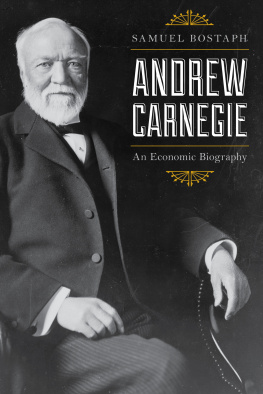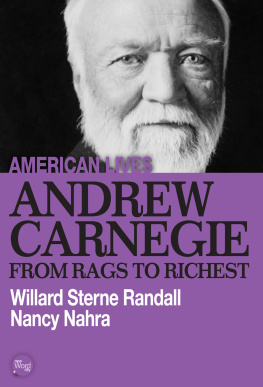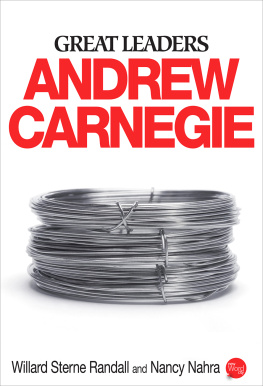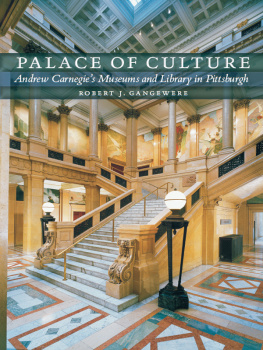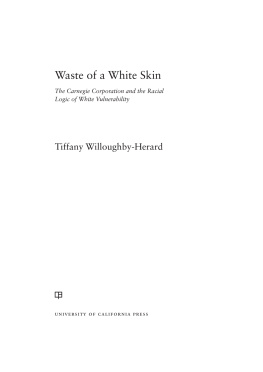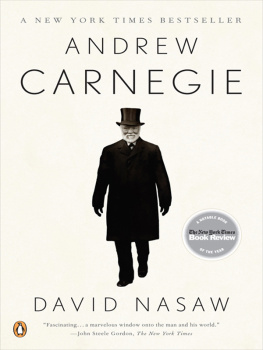PRAISE FOR A World Of Giving
New foundations, appearing at a rapid rate, can benefit from a history lesson. Here it is at its bestthe compelling story of the idea of the gift into perpetuity, and the practices that followed.
KENNETH PREWITT, Carnegie Professor of Public Affairs, Columbia University, and former director, United States Census Bureau, senior vice-president, Rockefeller Foundation, and president, Social Science Research Council
A World of Giving chronicles the values, practical idealism, and a century of grantmaking set in motion by Andrew Carnegie, one of Americas great philanthropists. Along the way, the book delivers a wealth of wisdom for todays foundations and other philanthropies, especially the growing number working in the global arena.
SUSAN V. BERRESFORD, trustee of the California Endowment, the Henry J. Kaiser Family Foundation, and the Robina Foundation, and former president of the Ford Foundation
Patricia Rosenfields study of the first century of Carnegie Corporations international philanthropy is a must read for both scholars and practitioners in the field. Drawing from her career at Carnegie Corporation and her analysis of the Corporations extensive archives, Rosenfield traces the evolution of Carnegies grant making from the early days of funding libraries and education to its current work building human capital and promoting peace and security. She focuses on the interplay of mission, the willingness to take risks and to fail, openness to long-term investments, and an ability to collaborate with other funders and local partners. At a time of burgeoning international giving by American foundations and the rise of funders around the globe, A World of Giving provides an important historical case study as well as a guideline for the practice of global philanthropy in the twenty-first century.
JOAN SPERO, Senior Research Scholar at Columbia Universitys School of International and Public Affairs, and former President of the Doris Duke Charitable Foundation, and US Under Secretary of State for Economic, Business, and Agricultural Affairs
A World of Giving is a welcome addition to the growing corpus of literature on foundations and philanthropy. It stands out because its written by someone intimate with her subject matter and who has a scholarly command of the institutional history. Patricia Rosenfield excels at contextualizing the American century of philanthropy by demonstrating how the institution pioneered much of what is now taken for granted as indispensable ingredients of modern philanthropy as it is practiced globally today.
GERRY SALOLE, Chief Executive, European Foundation Centre and Chair, TrustAfrica, and former Ford Foundation Representative, Southern Africa
A World of Giving is a landmark record of what men and women of financial, intellectual, and social resources have accomplished and continue to accomplish in confronting national and global realities. Such a study provides hope and inspiration. The author has organized a voluminous amount of information in an impressively clear, systematic way making it easy to follow the history of Carnegie Corporations work over the past century as each new president and administration added fresh ideas and tried new approaches. The reader will certainly appreciate how much Carnegie Corporation, a primary link in an increasingly interconnected world, and other foundations have contributed to building bridges and searching for solutions to some of the worlds most intractable problems.
AKIRA IRIYE, Professor of American History Emeritus at Harvard University and University of Chicago, and a co-editor of Global Interdependence: The World after 1945
A WORLD OF GIVING

Copyright 2014 by Carnegie Corporation
Published in the United States by PublicAffairs, a Member of the Perseus Books Group
All rights reserved.
ABOUT CARNEGIE CORPORATION OF NEW YORK
Carnegie Corporation of New York was created by Andrew Carnegie in 1911 to promote the advancement and diffusion of knowledge and understanding. In keeping with this mandate, the Corporations work focuses on the issues that Andrew Carnegie considered of paramount importance: international peace, the advancement of education and knowledge, and the strengthening of democracy.
No part of this book may be reproduced in any manner whatsoever without written permission except in the case of brief quotations embodied in critical articles and reviews. For information, address PublicAffairs, 250 West 57th Street, 15th Floor, New York, NY 10107.
PublicAffairs books are available at special discounts for bulk purchases in the US by corporations, institutions, and other organizations. For more information, please contact the Special Markets Department at the Perseus Books Group, 2300 Chestnut Street, Suite 200, Philadelphia, PA 19103, call (800) 810-4145, ext. 5000, or e-mail .
Book Design by Janet Tingey
LIBRARY OF CONGRESS CATALOGING-IN-PUBLICATION DATA
Rosenfield, Patricia L.
A world of giving : Carnegie Corporation of New YorkA century of international philanthropy / Patricia L. Rosenfield.First Edition.
pages cm
Includes bibliographical references and index.
ISBN 978-1-61039-430-7 (ebook)
1. Carnegie Corporation of New YorkHistory.
2. CharitiesUnited States. I. Title.
HV97.C3R67 2014
361.7650973dc23
2013037928
First Edition
10 9 8 7 6 5 4 3 2 1
THIS VOLUME IS DEDICATED TO the generosity of one individual, his remarkable wife, and his family. Andrew Carnegie, his helpmate Louise, and their devoted daughter Margaret, all participated in the joyful but ceaseless work of giving away Mr. Carnegies fortune. The bold spirit of the Carnegie family and their descendants has resulted, as this volume shows, in long-lasting societal transformations.
CONTENTS
WHEN ANDREW CARNEGIE LAUNCHED Carnegie Corporation of New York in 1911, his institutional vision inspired the field of modern philanthropy. Carnegie had already defined a new rationale and style for philanthropic giving. For more than twenty years he had been writing about and experimenting with a variety of approaches to philanthropy. Carnegie Corporation of New York was his final major American endowment.
Carnegies radical premise declared that money amassed by successful capitalists was not ultimately for their personal purposes, but rather that they held the funds in trust for the public and therefore should return those funds to the public. In his seminal 1889 essay Wealth, he proclaimed that the man who dies thus rich dies disgraced. This premise, arguably, launched modern philanthropy by eschewing the notion of giving for charity, that is, the short-term alleviation of human suffering. Instead, he embraced the notion of philanthropic giving to advance knowledge of the root causes of societal problems and to share that understanding widely, the mission he consequently bestowed on Carnegie Corporation of New York.
In todays world, a century later, when the concept of a philanthropic grant-making foundation is so widely accepted, it may be hard to understand what a conceptual breakthrough Andrew Carnegies writings and subsequent actions constituted. Although philanthropic activities had been a constant of American life since the 1700s, the establishment of endowed
To set the context for Andrew Carnegies bold creativity, imagine his challenge as the richest man in the world. He sold his company in 1901 for $492 million, the largest financial transaction of its day.
To ensure that he could give away all his money before he died, in 1911 Andrew Carnegie, the philanthropic industrialist, and Elihu Root, Americas leading statesman and Carnegies lawyer, designed a public trust corporation intended to give the money away in perpetuity and to support the most creative and talented people of future generations. The founding of Carnegie Corporation of New York (the Corporation) began the age of the general-purpose foundation that gives grants to others. That is, in contrast to the operational foundations established earlier in the century, the institution would invest in the ideas and projects presented to itto be carried out not by its staff but by people and institutions outside it. The Corporations trustees would both decide and monitor implementation by others. The aim was to make a lasting difference by advancing the understanding of mankinds problems and by widely sharing that knowledge.
Next page

